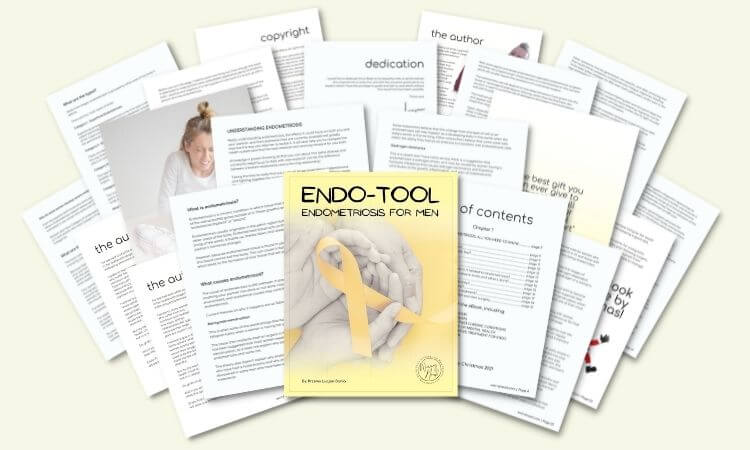Is endo a medical term?
Yes, endo is a medical term, but even though it has many meanings, I am going to refer to it in terms of endometriosis since this health blog is about this chronic condition.
Firstly though, what does endo mean?
Endo medical term is derived from the Greek word “endōs” which means “within”. This prefix is often used in medical terms to describe something located or happening within the body, such as endocarditis and endometriosis.
My reasons why?
Many women have their endometriosis diagnosed on average in 7 to 8 years. It took my wife only 5 years to diagnose endometriosis. She was additionally diagnosed with fibromyalgia, and today (Christmas 2022) she goes through tests to find out if she has breast cancer.
Endometriosis affected her fallopian tubes, ovaries, her bladder, bowel, and intestines. She has 4 cysts on both ovaries, including three endometriomas.
What does endo mean?
The Greek word “endōs” means “within”, but there are many medical conditions that endo is used to describe, including many common conditions such as:
- endocarditis
- pericarditis
- endocrine disorders
- endometritis
- endolymphatic hydrops
Endo is also used to describe a variety of treatments such as:
- endoscopic surgery
- endovascular interventions
- endoscopy
I explain all of them below, but first, if you want to learn more about endometriosis, I wrote an “Endo-Tool, Endometriosis for Men” e-Book.
You can get the 1st Chapter of the e-Book for FREE, and if you like it, you’ll get a Whopping 33% Discount on the Whole Book, plus discounts on other helpful tools. You have nothing to lose but a lot to gain!
The first chapter alone contains all the comprehensive medical knowledge about endometriosis, including:
- What is endometriosis?
- What are the symptoms?
- What causes endometriosis?
- What does endometriosis look like?
- What are the stages?
- What are the types?
- What is adenomyosis and how is it related to endometriosis?
- Why do some women develop severe endo and others don’t?
- Does endometriosis cause infertility?
- How is endometriosis diagnosed?
- Do types and stages affect the treatment?
- Recurrence of endometriosis after excision surgery.
FREE Chapter of “Endo-Tool”
Endometriosis e-Book for Men

Endocarditis.
Endocarditis is an infection of the endocardium or inner lining of the heart. It is most often caused by bacteria that enter the bloodstream and travel to the heart.
Pericarditis.
Pericarditis is an inflammation of the pericardium, which is the outer layer of tissue that surrounds the heart. It is usually caused by a viral or bacterial infection but can also be due to autoimmune diseases, such as Lupus or Sjogren’s syndrome.
Endocrine Disorders.
Endocrine disorders are conditions that affect the endocrine system, which is responsible for producing hormones. Common endocrine disorders include diabetes, thyroid disease, and adrenal gland disorders.
Endometritis.
Endometritis is an infection of the endometrium, which is the inner layer of the uterus. It is usually caused by bacteria and can be accompanied by pelvic pain, abnormal bleeding, and fever.
Endolymphatic Hydrops.
Endolymphatic hydrops is a rare condition that affects the inner ear, usually resulting in hearing loss and tinnitus. It is caused by an accumulation of fluid in the inner ear, which can lead to pressure on the nerve endings and cause hearing problems.
Endoscopic Surgery.
Endoscopic surgery is a minimally invasive surgical procedure used to access the interior of a body cavity or organ. It is often used to diagnose and treat conditions such as gallstones, ulcers, hernias, and gastroesophageal reflux disease (GERD).
Endovascular Interventions.
Endovascular interventions are minimally invasive procedures used to repair narrowed or blocked arteries without open surgery. Common endovascular interventions include angioplasty, stenting, and atherectomy.
Endoscopy.
Endoscopy is a diagnostic procedure used to examine the inside of a body cavity or organ. It can be used to diagnose and treat digestive conditions such as Crohn’s disease, ulcerative colitis, gastritis, and celiac disease.

Endo is endometriosis.
In particular, endo is the prefix for endometriosis, a chronic condition affecting 10% of women.
In terms of the word “endometriosis” in Greek, it means “inside the uterus”.
In the endometriosis community, endo is often used in reference to the condition because it gives a sense of connection and support to those who suffer from it.
Endometriosis is a condition in which tissue similar to the one that normally lines the uterus grows in other areas of it, outside the uterus. However, you need to know that endometriosis is a full-body condition, and doesn’t relate solely to the pelvic area.
Women with endometriosis often experience severe pain and heavy periods. It is also one of the most common causes of female infertility.
The growth of endometriosis tissues has to be removed with a surgery called “laparoscopy”, or the surrounding areas of the womb will become worse and begin to grow in other places, such as the lungs, and in rare cases in the eyes or brain.
The treatment of endometriosis.
Endometriosis can be treated with drugs, surgery, or a combination of both. The goal is to reduce pain and protect fertility.
Women are often put into temporary menopause. The gonadotropin-releasing hormone, or GnRH agonists, can shut down the ovaries and decrease estrogen levels, which can oftentimes reduce endometriosis symptoms.
Even though things like endometriosis patches are also given to help reduce pain, this is not a cure.
Research shows that surgery is the most effective way to get complete relief from endometriosis pain. Laparoscopic excision surgery is the gold standard for treating endo. This procedure can remove endometrial tissue, scar tissue, and endometriomas. It is also the only procedure that can definitively diagnose endometriosis.
The American College of Obstetrics and Gynecology recommends laparoscopy for the surgical treatment of endometriosis. To remove endo tissue, other procedures may include cystectomy, unilateral oophorectomy, and adhesiolysis.
The prefix…
Endo can also be used as a prefix to create more specific medical terms. For example, endocarditis is an inflammation of the inner lining of the heart chambers and the endomyocardial is the innermost layer of the heart muscle.
Endo can also be used to describe any procedure or instrument that applies to parts inside the body. For instance, endoscopy is a procedure used to examine the inside of a person, the cavity organ, and an endoscope is a long, thin instrument that is inserted into the body to visualize and inspect areas inside the body.
By understanding endo and what it means, patients and healthcare providers can ensure that the correct term is used in medical situations and make sure that accurate diagnosis and treatment are provided.

Conclusion.
In addition to all the above, endo is also used in various fields such as pharmacology and biochemistry to describe biochemical compounds or drugs that are used to treat internal organs and medical conditions, a diverse range of procedures, and instruments.
Keeping endo in mind when discussing medical matters can be beneficial for both healthcare professionals and patients. Understanding endo can also help when searching for information related to the diagnosis or treatment of medical conditions, as endo can be used to refine searches and help find more relevant information.


About Me
Hi, I’m Lucjan! The reason why I decided to create this blog was my beautiful wife, who experienced a lot of pain in life, but also the lack of information about endometriosis and fibromyalgia for men…
